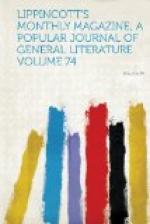F. A.
NOTES.
If it be true, as a writer in the February Gossip says, that “it is what Mr. Mill has omitted to tell us in his Autobiography, quite as much as what he has there told us, that excites popular curiosity,” the following anecdote told by John Neal, one of Jeremy Bentham’s secretaries, may be found interesting. The father of John Stuart Mill, it seems, was in the habit of borrowing books of Bentham, and was even allowed the privilege of carrying them away without asking permission—a courtesy so well utilized that from five to seven hundred volumes found their way in time from Bentham’s library into the study of the elder Mill. He was a more conscientious borrower, however, than most of his class are, for he had a case made for these books, kept them carefully locked up, and carried the key in his pocket. This put the owner to some trouble occasionally when he wanted to consult his books. In one instance he begged Mr. Mill to leave the key when the latter was going out of town. In vain, however, for Mill marched off to the country carrying the key with him, and Bentham had to wait a whole month for a peep at his own books. If we could know all the facts, doubtless it would be found that Mill knew too well the careless habits of the philosopher to trust him to such an extent. It is not prudent to decide until the evidence is all in. It is that these books—two or three thousand dollars’ worth, according to Neal—were, on the death of Mr. Bentham, all recovered by his heir.
Quarritch, a London bookseller, lately advertised for sale a Chinese book from the library of the emperor Khang-Hi, bearing the following title: Yu Sionan Row-wen youen kien—that is, “Mirror of the Profound Resources of Ancient Literature,” being extracts from those profound resources arranged chronologically in the order of their production; but the singular thing about the book is its typography. It is printed in inks of four different colors. All the articles dating from the time of Confucius (B.C. 550) to the Mongol dynasty (A.D. 1260) are printed in black, with punctuations in red. All names of persons and places are upon scrolls, to distinguish them from the ordinary text. Observations upon the emperor Khang-Hi (who annotated the whole book autographically) are printed in yellow, the color of the reigning dynasty; those upon scholars and authors living at the time of the publication of the book are printed in red, the color of the living; those upon persons deceased in blue, the mourning color of China. The work is in twenty-five volumes, preserved in four cases. It was printed in 1685.




